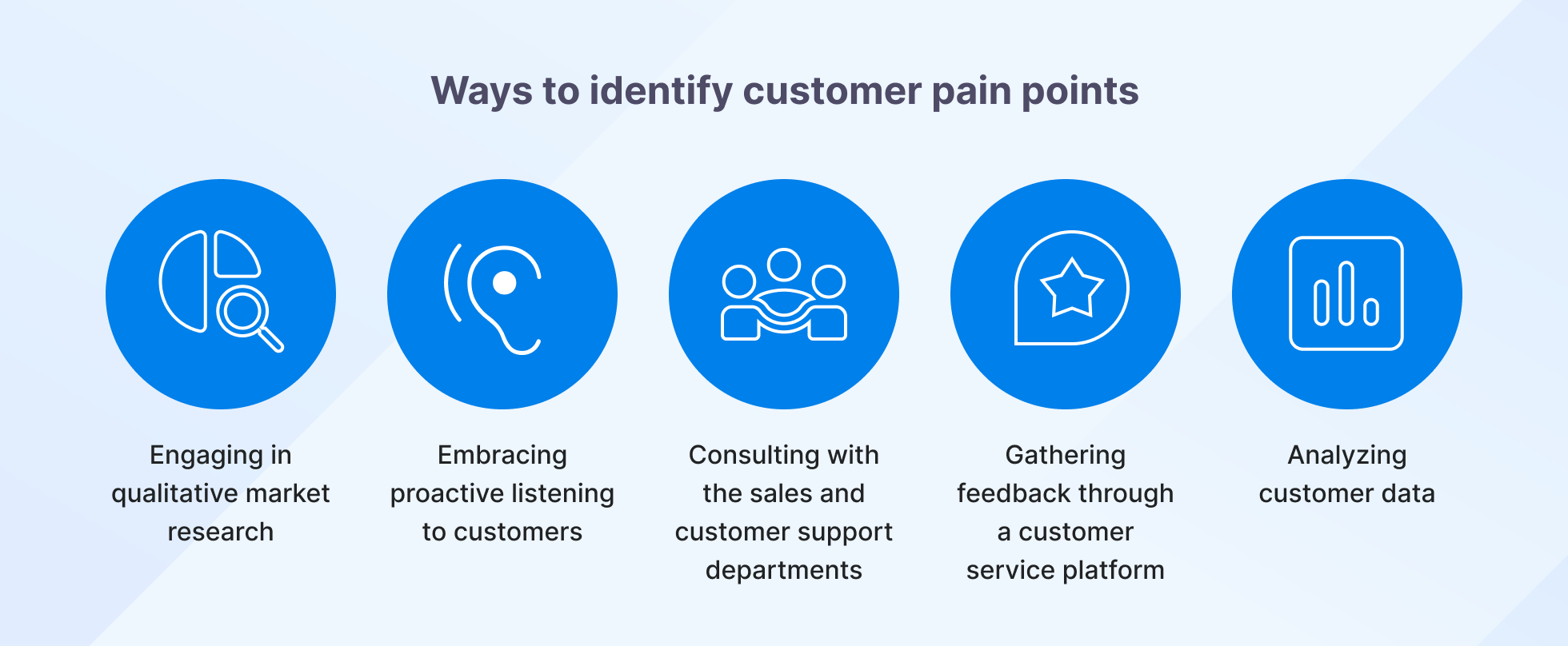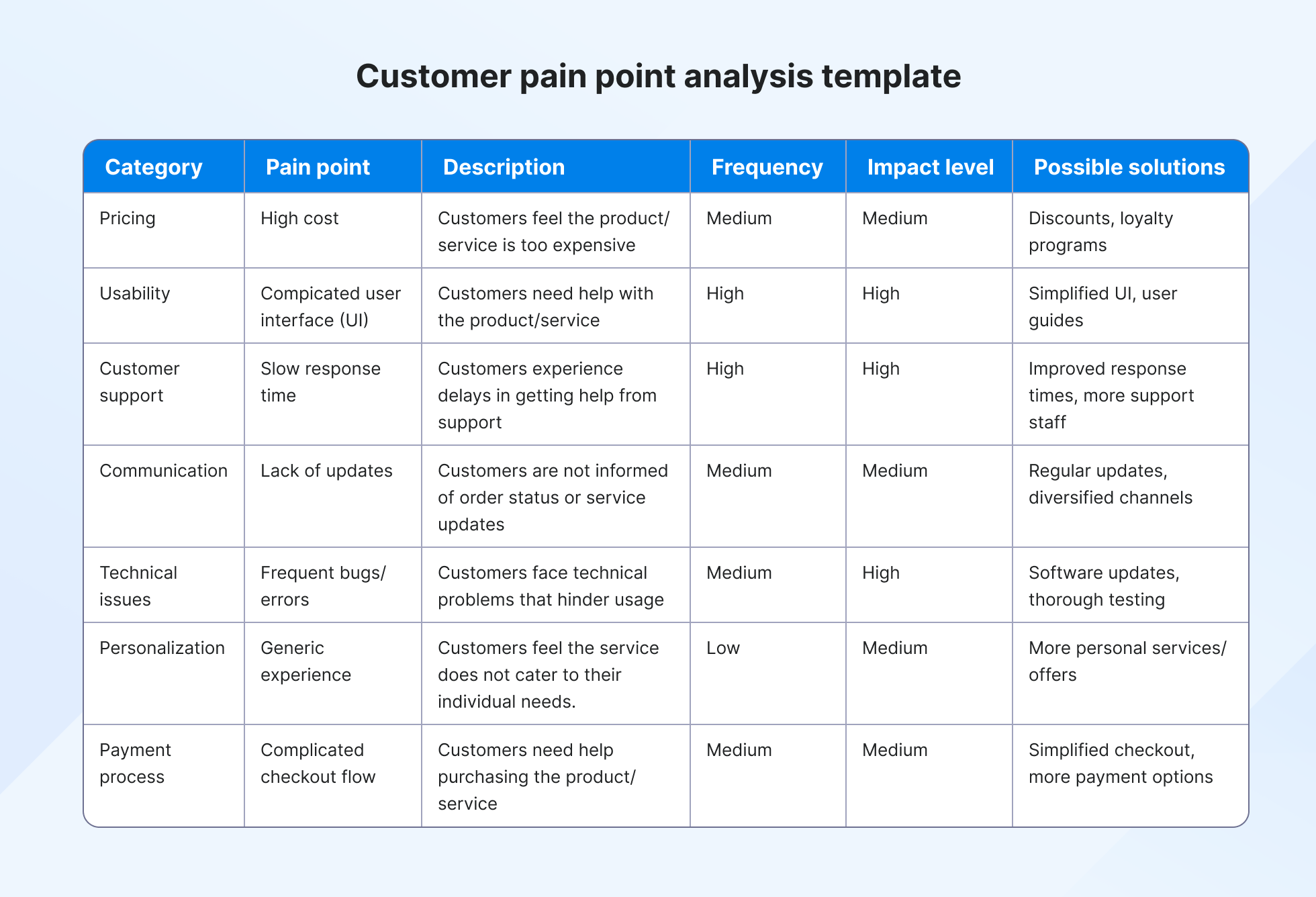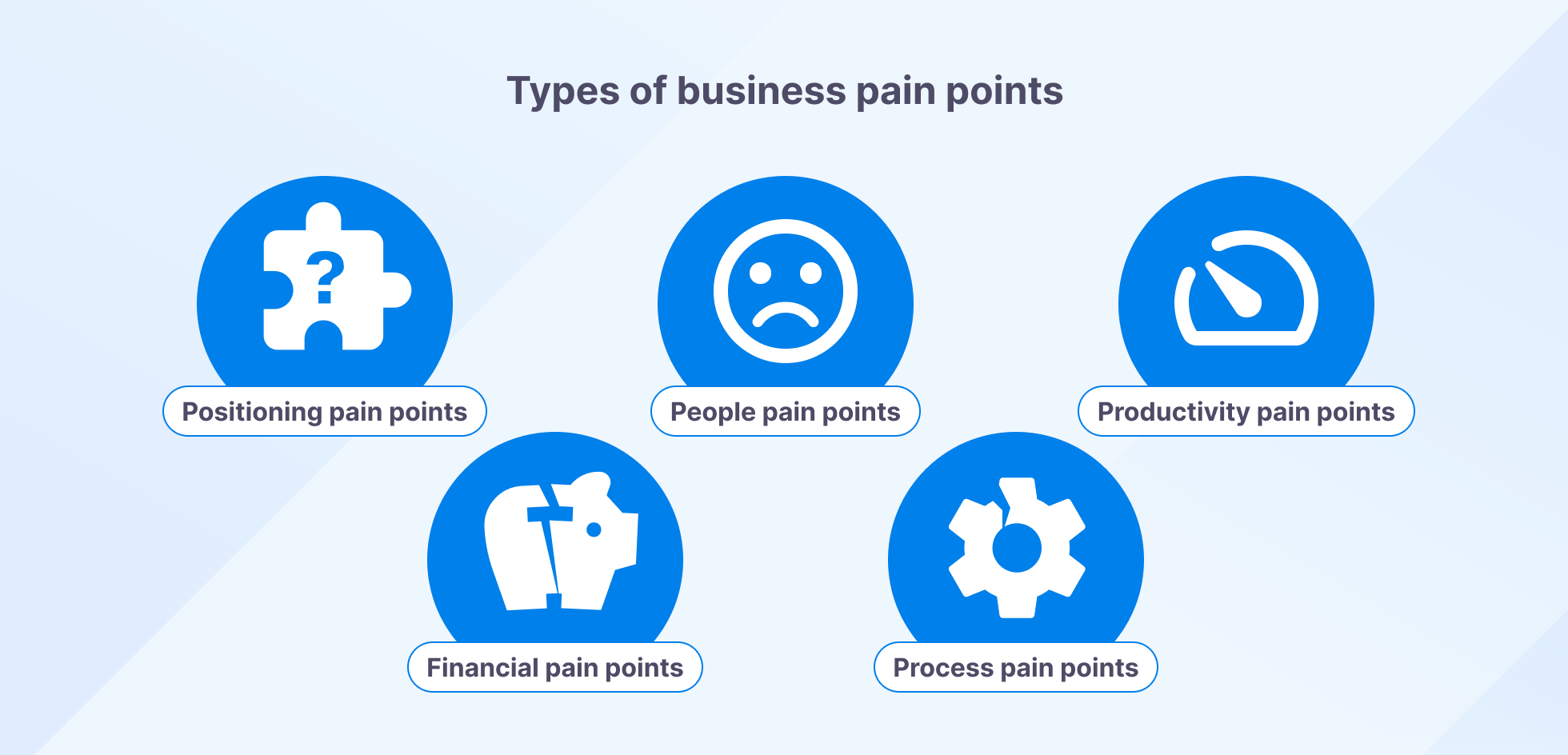
Have you ever examined your customers’ journey from interest to conversion and noticed significant gaps between cart additions and completed checkouts? Well, these gaps can be caused by what the industry defines as “customer pain points” — little drawbacks that steer customers away.
Understanding your customers goes beyond just offering a product or service. It’s about walking in their shoes, feeling their frustrations, and actively addressing the hurdles they encounter.
In this blog post, we will break down customer pain points and highlight their significance. We’ll also provide some real-life examples of pain points and share some tips on overcoming them.
What are customer pain points?
Customer pain points refer to those specific instances where customers encounter issues, inconveniences, or glitches that hinder their interaction with a product or service. These moments hold considerable influence over how customers perceive your company — they can influence how customers compare your products to those of your competitors.
Understanding customer pain points can help you identify areas for improvement. Here are a few pointers that highlight the importance of addressing customer pain points.
- Improved product quality: Recognizing pain points helps refine product features.
- Guided investments in research and development (R&D): Insight into customer pain points directs the allocation of resources toward R&D efforts. This enables you to find innovative solutions that directly respond to customer needs.
- Enhanced brand perception: Addressing pain points improves your brand’s reputation. Customers value companies that listen to their feedback.
- Competitive advantage: Proactively addressing customer needs allows you to attract and retain customers, helping you maintain a competitive edge.
Pain points should be an all-around business department concern. Fostering a customer-centric company culture where customers feel heard should always be your number one goal.
Aside from having the marketing and sales teams address customer pain points in their communication strategies, product management should also be involved.
🧩 For example, in a product-led growth (PLG) model, solving customer pain points first and providing value through the product are the pillars of a PLG approach.
How to identify customer pain points
Pain points are as varied and distinct as the individuals encountering them. They range from worries about high costs and subpar products to inquiries about broken links or unsatisfactory customer experiences.
So how can one successfully pinpoint them? Here are five ways to effectively identify customer pain points:

1. Engage in qualitative market research
Qualitative market research goes beyond numbers. It involves engaging with customers and inviting them to share their feedback in their own words. This differs from quantitative research, which often involves rating items on a scale.
Unlike quantitative surveys, which limit responses to predefined topics, qualitative research allows customers to express exactly what bothers them about a product. This approach creates opportunities to uncover pain points that might not have been on your radar.
Consider conducting qualitative research externally. Outsourcing could be a viable option if you lack the capabilities to run this type of research in-house. Elisa Montanari, head of organic growth at Wrike, shared her view on why this is such a crucial step:
2. Embrace proactive listening to customers
Proactive listening is a cornerstone for revealing customer pain points. Instead of just hearing customers out when they voice concerns, it is essential to engage with them and strive to resolve their problems before they reach out to you.
🤳 By monitoring social media platforms and review sites, you can tap into the broader sentiment around your brand.
3. Consult with the sales and support departments
Frontline teams like sales and customer support interact directly with customers. Initiating open discussions with these teams can offer valuable insights into the challenges customers face, their concerns, and the common issues that arise.
If possible, aim to centralize all customer communication (customer service, sales, marketing) on a single platform. This provides transparency among teams and contributes to a clearer understanding of customers.
Regular meetings or brainstorming sessions with sales and customer support teams can help reveal pain points that customers might not openly express. Albert Kim, VP of talent at Checkr, explains how important these meetings are:
4. Stalk your competition
Keeping a close eye on your competitors can provide valuable insights into customer pain points that you might have overlooked. After all, they’re targeting the same audience as you and likely making some mistakes along the way.
🕵️♂️ Review your competitors’ social media channels, websites, and customer reviews, and pay attention to what their customers are complaining about. Use competitive analysis tools like Semrush or BuzzSumo to gather data on market trends and customer preferences.
5. Analyze customer data
After gathering solid feedback on your customers’ pain points, delving deeper into the data it generates provides a richer perspective.
If you’re not already doing so, consider keeping tabs on metrics like:
- Conversion rate and the factors influencing it
- Customer churn rate and the reasons behind it
- Average time to resolve issues and the underlying reasons
Customer pain point template
A customer pain point template can help you identify the most pressing pain points by providing a structured framework for the following aspects.
- Categorization and prioritization: You can organize the pain points based on factors like frequency, severity, and customer segment, making it easier to prioritize which issues need immediate attention.
- Standardized reporting: It establishes a consistent format for reporting and analyzing customer pain points, facilitating data-driven decision making and ensuring that everyone in the organization is on the same page.
- Identifying patterns and trends: By analyzing the data collected, you can identify recurring patterns and trends, revealing underlying issues that might otherwise go unnoticed.
- Empathy and understanding: The process of filling out the template encourages teams to step into the customer’s shoes and understand their perspective, building a more customer-centric approach.
Use the below template to gather data and analyze your customers’ pain points. Adapt it to suit your needs and ensure that you’re addressing what truly matters to your customers.

The most common types of pain points in business
Say you’ve conducted the above customer pain point analysis and compiled a provisional report.
If you operate in the business-to-business (B2B) landscape, the following list of customer pain points summarizes the challenges your clients face on a regular basis:

Positioning pain points
Positioning pain points represent businesses’ difficulties with differentiating themselves from competitors. They can also arise when businesses struggle to effectively reach their target audience.
Here are some positioning challenges that can impact a company’s strategic efforts:
- The company has limited visibility in the market
- A competitor has a more prominent presence on most channels
- The company is disadvantaged owing to competitors’ greater spending
- The changing market landscape is causing the company to feel left behind
Financial pain points
Financial pain points represent challenges businesses experience when managing their finances and assets. These pain points can hinder financial stability and impact the overall business health score.
Here are some everyday instances of financial pain points:
- High operating costs
- Difficult access to capital
- Ineffective debt management
- Inconsistent cash flow management
- Complex tax reporting requirements
People pain points
Employees are central to any business. When employee-related challenges arise, they can trigger ripple effects across various business dimensions.
Examples of such problems include the following:
- Employees experience low morale
- A lack of diversity within the workforce impedes innovation
- The company’s declared culture does not align with its actual practices
- Top talent retention is a challenge due to better-paying opportunities elsewhere
Process pain points
Process pain points are related to inefficiencies in a company’s customer engagement strategies. These weaknesses not only impact customers but can also harm the company’s support team.
The pain points linked to processes might involve:
- Excessive bureaucracy
- Limited process scalability
- Low level of process digitization
- Lack of standardized procedures
- An inefficient help center failing to assist customers within the anticipated time frame
Productivity pain points
Productivity pain points arise when a business experiences time-wasting inefficiencies that stand in the way of increasing profits.
Examples of productivity pain points include:
- Lack of clear business objectives
- Too many meetings and an overwhelming workload
- An inefficient and complicated onboarding process for new hires
- The ineffective utilization of tools — where there’s excessive reliance on manual tasks
Real-life pain point examples and resolutions
Once you better understand your clients’ pain points, it becomes more straightforward to address them effectively.
Here, we’ve compiled seven typical pain point examples identified by both small businesses and enterprises. We’ve also included some actionable tips for each.
1. Customer support responses take too long
Prompt and efficient customer support is integral for maintaining customer satisfaction, loyalty, and positive brand perception. Delayed responses can lead to frustration, erode trust, and potentially result in customers seeking out alternatives.
Here’s how to solve slow customer support response time:
- Use a ticketing system that automatically assigns and tracks support inquiries
- Integrate artificial intelligence-powered chatbots to handle common inquiries and provide instant responses
- Once a customer submits a support request, communicate the relevant service service-level agreement response time to them
2. Support is unavailable on the expected channel
Providing accessible support is crucial for customer retention. When customers can easily reach out for assistance, it shows that your company values their needs. If customers are left hanging without support, they might start to feel neglected and unimportant.
Here are some ways to enhance support team availability:
- Establish multiple channels for customer support — e.g., phone, email, live chat, and self-service portals
- Offer extended support hours to accommodate various time zones
- Focus on scalability to ensure support availability during peak demand periods

3. Customer service reps showcase an offensive attitude
Customers immediately feel disappointed when a customer service rep treats them in a rude or unprofessional way, and eventually, they stop being loyal to your company.
Consider these suggestions to address your support reps’ less-than-ideal behavior:
- Establish a feedback system where customers can rate their support experience
- Integrate empathy as a core principle and celebrate instances that positively impact customers
- Implement quality assurance measures to monitor support interactions and improve customer service
4. Product and service quality is inconsistent
Inconsistency in product and service delivery can have devastating consequences, including negative reviews and a gradual decline in the company’s market reputation.
Here are some targeted solutions to elevate consistency in product and service quality:
- Establish clear quality standards and communicate them throughout the organization
- Regularly audit products, services, and customer feedback to identify deviations
- Invest in quality management systems to monitor and maintain consistent standards
5. There is a lack of appropriate training and expertise
When employees lack adequate skills and understanding, tasks take longer to complete, and errors can accumulate.
If you’re dealing with a lack of expertise within your company, here are some approaches you can adopt:
- Provide resources such as podcasts and customer service books
- Encourage employees to attend relevant workshops and conferences
- Establish an internal knowledge-sharing ecosystem that includes white papers and training sessions
- Foster mentorship and collaboration among experienced professionals and newcomers to create an environment of continuous learning
6. The buying process is problematic
Neglecting user-friendliness and knowledge gaps can harm the conversion rate. Customers struggling to navigate or find information may simply give up, which could result in lost deals and a negative perception of your company.
Here’s how to overcome a complicated buying procedure:
- Identify redundant stages in the buying process and eliminate them
- Provide clients with clear insights into each step of the buying process
- Provide a number of different payment options — customers will be more likely to complete their purchases when they can use their preferred payment methods
7. Solutions do not align with customer needs
Providing one-size-fits-all solutions can result in customers leaving in search of better options. The mismatch between what’s offered and what customers truly need or want can trigger a cycle of dissatisfaction.
Here are three actionable insights into tailoring solutions to your customers’ needs:
- Dedicate time to fully understand each customer’s challenges, objectives, and requirements
- Analyze what competitors are offering, and identify gaps — developing solutions that bridge these gaps can give you a competitive edge
- Proactively anticipate potential issues before customers even realize they are in need of a solution
Alleviate pain points for happier customers
Building lasting relationships starts with grasping and resolving customer pain points. From recognizing challenges to actively addressing your customers’ pain points, one thing is clear — relying solely on empathy isn’t enough.
Actively listen to your customers and monitor your competitors to uncover and address critical concerns. Based on customer feedback, take proactive steps to constantly improve your products and services.
Related articles
Text message marketing and database maintenance
In our increasingly connected world, text message ma...
The ultimate apology email to customers: 15 Effective templates plus tips
An apology email to customers serves as a crucial to...
Mastering customer segments: Strategies to boost your ROI
One of the most effective ways to differentiate your...
7 Tested Ways to Use Texting for Your Small Business [Infographic]
Using digital tools for communication is now a stapl...
10 Simple tips to building a great small business website
To successfully run a small business, you need to fi...




